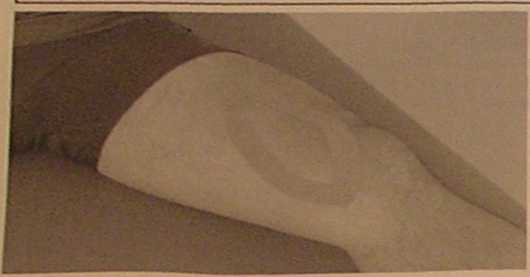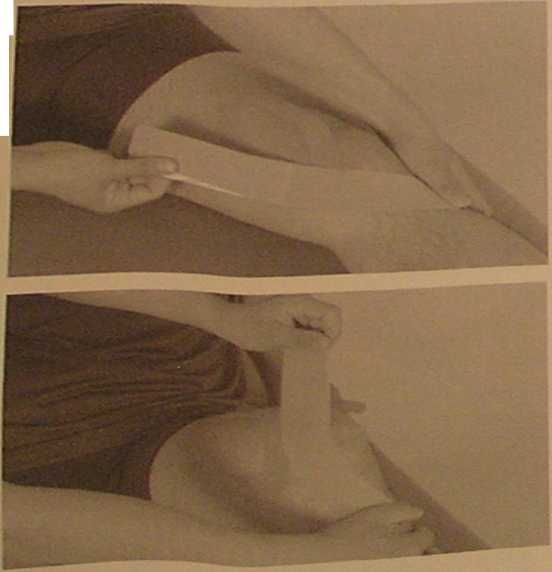P5140092
Chondromalacia Patella
Chondromalacia patella is a softening and degeneration of the under surface of the patella. The exact cjuse is unknown, generałly it is related to patella tracking abnormalities, inereased quadriceps angle, abnorrnal patella alignment, and musełe wcakness, just to name a few. Patients with the possible list of causes sometimes do not develop chondromalacia, some without any known factors develop chondromalacia. The condition is generałiy associated with inflammation surrounding the patella, media! patella retinaculum pain, and inereased symptoms with inereased activity levels.
The Kinesio taping method will assist by red u ci ng pain, inflammation, and if indicated provide proprioceptive stimuli to alter patella tracking.
For additional reference of Kinesio taping technique options see patella tracking syndrome page ?.



Following evaluation the practitioner may deter-mine muscle weakness as a causative factor in the chondromalacia patella. For this example the vastu$ medialis is involved.
For an acute inflamed or overused muscle use the insertion to origin application technique. For a chronić weakness or weakness resulting from sur-
gery use an origin to insertion application technique.
This example is demonstrating the origin to insertion technique.
The primary therapeutic goal of Kinesio taping for Chondromalacia patella is to reduce inflammation as a result of the effusion caused by the hyalinc cartilage degeneration.
A modified space correction technique will be applied. For complete review of space correction techniques.
Begin by applying a Kinesio 1 strip to the tibial tuberosity of the tibia with no tension and the kneein extension. Angle the Kinesio strip so it will be placed with one half of the Kinesio Tex above and below the lateral or medial border of the patella.
With one hand hołd the initial application base to ensure no tension will be added. Apply light to moderate tension, 25-50%, for this technique less is usually better. As the tension is applied to the Kinesio strip, instruct the patient to move their knee into flexion. As the patient moves their knee into flexion, apply the Kinesio strip around the patella to approximately the patella apex.
Lay down the last approximatcly two inchcs of the Kinesio strip down with no tension. Initiate glue activation prior to any further patient movemcnt.
Repeat the above steps on the opposite side of the patella. When the patient moves their knee into extension following the application tcchnique, convolutions should be visible surrounding the patella. If convolutions are not evident, the Kinesio strip was applied with to much tension.
Optional tpfhnigup: I Strip
Once the described technique is applied, the practitioner may determine that patella alignment correction may be beneficial.
The use of the m echa ni cal correction techniąue for patella tracking may be appropriate. Technique application depicted in photo is for lateral tracking using an I strip.
For complete review see patella tracking techniąue.
Other patella alignment abnormalities may be present, this is oniy given as an example of one potential problem.
Optional technigue: Mechanical Correction Tension on Base
Once the described technique is applied; the practitioner may determine that patella alignment correction may be beneficial.
The use of the mechanical correction techniąue for patella tracking may be appropriate. Techniąue application depicted in photo is for lateral tracking using tension on the base.
For complete review see patella tracking techniąue.
139
Wyszukiwarka
Podobne podstrony:
DSC09926 GLOBAL HYPOXIC-ISCHEMIC ENCEPHALOPATHY Morphology: the brain is softened and edematous with
Classroom Management ways in which studeni*s behaviour, movement, interaction is organized and contr
Writing the Codę Now that the microcontroller is powered and hooked up the codę needs to be loaded t
Report 8 67 Cherutich Site preparation: A drill rig is heavy and because of the high loads invoIved,
S5002276 Ustawienie Figurę 1: To ensure that the tool is square and perpendicuiar to the workpiece,
When the time of loading information is constant and independent of the length of a register, then w
monika�1 This is a black and white kitten. The kitten is wearing a mitten. This is a little red fox.
>>> 2+2 4 >>> # This is a comment ... 2+2 4 >>>2+2 # and a comment o
CHU0922W0102 Condition Terminal A B Oil level is between F and L marks on the dipstic Oil level
146 chondrocyte differentiation pathway and is required for expression of Sox5 and Sox6. Genes Devy
P5140086 Patella Tendonitis: Superior and Inferior Pole Patella tendonitis at either the superior po
Future & Conditional Futurę & Conditional The futurę is usually formed by taking the infinitive
image002 Brian Aldiss is one the most influential -and one of the best - SF writers Britain has eve
image004 SOMETIMES YOU HAVE TO FIGHT FIRE WITH FIRE. THE YEAR IS 2032. AND SOMETIMES IS NOW. In 1996
[ fic]?nedictus,?vid The Fourth of June SF1 with its totems and taboos, is a place for a boy wit
00424 ?4589320c2ec691373ff85747154741 428 Pignatiello & Ramberg the process is in-control or is
więcej podobnych podstron